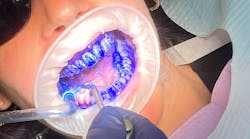It is increasingly evident that the connection between oral health and general health is profound. We educate our patients to keep their mouths healthy so they can have healthy teeth, gingiva, and pleasant breath, but also to minimize risk for systemic disease.
We tend to be pressed for time during the day, so it is common to identify clinical indicators that demonstrate the presence of disease. It may seem timeconsuming and complicated to provide clinical risk assessments prior to the presence of disease. TriPlaque ID is a disclosing agent that can help the clinician to gain a better understanding of the characteristics of a patient’s biofilm. It is easily applied with a microbrush. The disclosing agent is a deep purple color (figure 1) and once it is rinsed from the teeth, this disclosing agent has the capability of identifing three types of dental plaque (figures 2 and 3): Dark purple plaque: this biofilm has been present on the teeth for 48
In addition to helping identify the characteristics of the biofilm present in a patient’s mouth, disclosing can provide effective patient education. Patients can recognize which areas of the mouth require more attention and work toward better at-home oral hygiene practices. Moreover, disclosing can aid the clinician when removing biofilm with subgingival air polishing.
TriPlaque ID is a simple and efficient tool to aid the clinician in providing an accurate risk assessment, thorough biofilm management, and relevant patient education.
Editor’s note: This article first appeared in Through the Loupes newsletter, a publication of the Endeavor Business Media Dental Group. Read more articles at this link and subscribe here.
Pamela Maragliano-Muniz, DMD, is the chief editor of DentistryIQ. Based in Salem, Massachusetts, Dr. Maragliano-Muniz began her clinical career as a dental hygienist. She went on to attend Tufts University School of Dental Medicine, where she earned her doctorate in dental medicine. She then attended the University of California, Los Angeles, School of Dental Medicine, where she became board-certified in prosthodontics. Dr. Maragliano-Muniz owns a private practice, Salem Dental Arts, and lectures on a variety of clinical topics.








